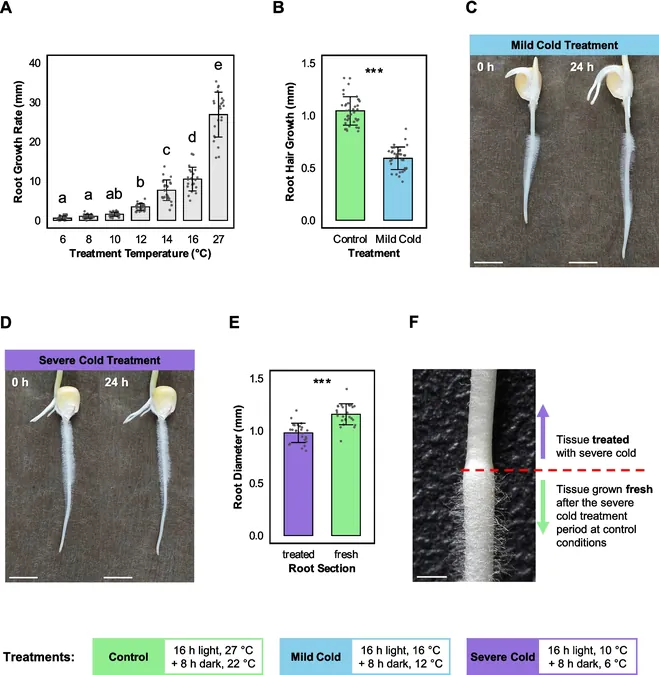
Unlocking the Cold Resistance of Maize: How Zea Mays Adapts to Frigid Temperatures
2025-09-22
Author: Emily
The Agrarian Legacy of Maize: A Battle Against the Cold
Domesticated over 10,000 years ago in Central America, maize has grown to become an agricultural powerhouse, critical for food, feed, and industrial applications. With its vast cultivation stretching from tropical to temperate climates, maize stands out amongst major crops. However, in temperate regions of Central and Northern Europe, it faces fierce challenges during its critical growth phases due to cold stress.
Cold Stress: A Looming Threat to Maize Productivity
Defined as temperatures dropping below the optimal growth range of 21 to 27 °C, cold stress wreaks havoc on maize, delaying seedling emergence and stunting plant vigor, ultimately reducing yields. The onset of climate change intensifies these challenges, increasing the urgency for maize varieties equipped with enhanced cold tolerance.
Root Hairs: The Unsung Heroes of Cold Resistance
Root hairs, which extend the root surface area to boost nutrient and water absorption, play a crucial role in helping maize survive cold conditions. Their development and resilience are intricately linked to various gene expressions that adapt to low temperatures, a process heavily mediated by hormones like salicylic acid and abscisic acid.
Unraveling the Gene Expression Puzzle Under Cold Stress
When exposed to cold, maize root hairs undergo a profound transformation, characterized by shifts in metabolic pathways and changes in gene activation. This intricate network, orchestrated by transcription factors such as C-REPEAT BINDING FACTOR (CBF), paves the way for the plant’s cold response.
Distinct Responses to Varying Cold Intensities
Research aims to identify how distinct transcriptomic modifications influence root hair morphology under cold conditions. By analyzing maize inbred line B73 under mild (16 °C) and severe cold (10 °C) conditions, researchers uncovered how these temperature variations trigger unique genetic responses.
Mild Cold: A Temporary Setback
Under mild cold treatment, root hair elongation is significantly reduced—down to 57% of the control—yet development remains relatively normal. This indicates a capability for recovery upon returning to optimal temperatures.
Severe Cold: An Irreversible Damage?
Conversely, severe cold exposure leads to bolstered stress responses but halts root hair growth completely. Return to warmer conditions shows a marked diameter increase in newly developed root sections, but previously affected root hair sections do not recover, indicating a permanent growth arrest.
The Transcriptomic Landscape of Cold Stress Responses
Detailed analyses reveal striking differences in gene expression patterns between mild and severe cold treatments. With a robust 3,401 differentially expressed genes (DEGs) for mild cold and an even larger count of 5,316 for severe stress, these findings suggest that the intensity of cold significantly dictates the plant's adaptive signaling mechanisms.
Cell Wall Modifications: Adapting to the Chill
Key enzymes involved in cell wall composition alteration also show differential regulation, hinting at maize’s strategy to maintain flexibility and integrity under cold stress. This includes notable downregulation of lignin biosynthesis, crucial for cell wall strength.
The Role of Hormones and Transcription Factors: A Network of Signals
Significantly, the interplay of hormones and transcription factors is pivotal in driving cold stress responses. Under mild conditions, upregulation of auxin and cytokinin-related genes supports root hair growth, whereas severe stress shifts the balance to stress-associated pathways.
Final Thoughts: The Constant Battle Against Chilling Stress
This comprehensive study highlights maize’s multifaceted response to cold stress—through morphological adaptations in root hairs and intricate modifications in gene expression. Understanding these pathways not only sheds light on maize resilience but could also pave the way for developing cold-tolerant crop varieties, crucial for future agricultural sustainability in a rapidly changing climate.









 Brasil (PT)
Brasil (PT)
 Canada (EN)
Canada (EN)
 Chile (ES)
Chile (ES)
 Česko (CS)
Česko (CS)
 대한민국 (KO)
대한민국 (KO)
 España (ES)
España (ES)
 France (FR)
France (FR)
 Hong Kong (EN)
Hong Kong (EN)
 Italia (IT)
Italia (IT)
 日本 (JA)
日本 (JA)
 Magyarország (HU)
Magyarország (HU)
 Norge (NO)
Norge (NO)
 Polska (PL)
Polska (PL)
 Schweiz (DE)
Schweiz (DE)
 Singapore (EN)
Singapore (EN)
 Sverige (SV)
Sverige (SV)
 Suomi (FI)
Suomi (FI)
 Türkiye (TR)
Türkiye (TR)
 الإمارات العربية المتحدة (AR)
الإمارات العربية المتحدة (AR)